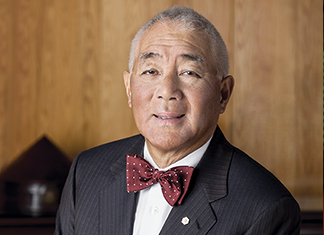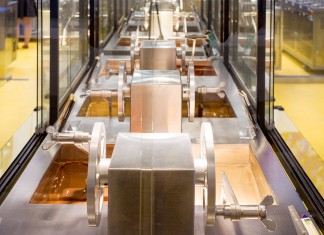In fine spirits: The return of the old business of distilling
- Caifu Magazine | by Caifu Global
- EN

“I love scotch, I love Scotch, Scotchy, Scotchy, Scotch,” says Will Ferrell in the 2004 film, The Legend of Ron Burgundy.
It would seem that since then the rest of the world has caught up with Ferrell/Burgundy’s love of fine spirits. Since 2004 the U.S market for whisky has been growing at a healthy 3-4 percent annually, with no signs of slowing.
In 2014 the total U.S market for blended and single malt whiskies was estimated to be approximately $2.5 billion. However, while not as large in total numbers the Asian market has had the most dramatic increases in recent years, with Mainland China seeing a 142 percent increase in whisky imports in 2013 over 2011 (although numbers are down slightly for 2014), for total imports of approximately $110 million; it’s not a huge market but clearly the growth potential is there. Singapore actually has the highest per capita consumption of Scotch whiskey at 12.1 liters per person, dwarfing U.K consumption, the home of Scotch whiskey, at 1.25 liters per person (Statista.com).
Japan has long been striving to compete in the world of fine whiskey, producing several highly respected brands, including Hibiki, one of the world’s most expensive whiskeys at $2,500 a bottle. The efforts of Japanese distillers have paid off with consumption of premium domestic spirits rising there in recent years.
As well Taiwan has joined the ranks of fine spirits producers, with the award winning Kavalan single malt whiskey (at a much more affordable price $120 a bottle).
In fact the growth of premium whiskey outside of Scotland prompted the Scotch Whiskey Association to update their guidelines in 2009 for the definition of Scotch whiskey, stressing that the only whiskey that can be referred to as Scotch is whiskey produced in Scotland, using Scottish water, malt and barley.
Even within Scotland itself the varieties of Scotch can be a little bewildering to the novice aficionado, which is the largest growing demographic worldwide of Scotch/whiskey consumers.
Tyler Schramm, the founder and owner of Pemberton Distillery (Pemberton is a picturesque, somewhat affluent village three hours north of Vancouver),studied at the highly respected Heriot Watt University in Edinburgh. He explains the differences between the four main regions of Scottish distilleries.
Speyside on Scotland’s north coast despite being one of the smaller regions (second only to Islay) has dozens of distilleries.
“Most of the big names in single malt whiskies come out of that region,” says Schramm. Big names include Glenfiddich and Macallan – the current favourite among the cognoscenti. Schramm concurs that Speyside distilleries are producing some of the finest Scotch available today.
Then there is Highland Scotch, which covers almost the entire north of Scotland (Speyside being the exception) and considered home to some of the most traditional distilleries, such as Glenmorangie, Cragganmore and is Ben Nevis (one of the oldest distilleries in Scotland). Tradition in single malt whiskies tends to mean a certain smoky flavor, or as Schramm says, “Highland whiskies will always contain a certain amount of peat”.
Then there is the Islay region to the south, which Schramm says, “typically Islay Scotch is heavily peated, very distinctive”. The last major of region is Lowlands distillers, who aren’t known for classic single-malt Scotches, but is instead home to the large blended distilleries such as Johnny Walker.
The rise in consumption of spirits (not just whiskies) in North America has led to a proliferation of small, or micro distilleries catering to a select (but growing market) of consumer who wish to imbibe not just premium spirits, but those with great attention to the highest quality (preferably local) ingredients.
Although Schramm and his older brother became distillers about seven years ago, it was based on the idea for their 'project’ of over a decade ago.
As noted Schramm did a Masters of Science in Distilling, and Brewing at Heriot Watt University, considered the education for those endeavoring to have a complete understanding of the distilling process.
Schramm returned to Canada to launch his distillery a little ahead of the curve in rising demand for fine craft spirits.
“I got back when the micro distilling industry was just taking off. Not much was happening in Canada, but worldwide whiskey was undergoing a rebirth, especially in Asian countries.”
He began with the basics, producing a vodka from locally grown potatoes. Then as soon as it was feasible they created their first whiskey (2010), which was partially released to great acclaim in 2013 (whiskey must be aged at least three years in oak casks to be considered whiskey). Most of their product will remain in casks and continue to mature, with only small lots of each year’s output released in three-year increments (and a just-released five year whiskey)
Schramm says they get their share of Asian visitors but don’t market to the Asian market. Though obviously he is more than aware of the rise in the appreciation for quality spirits, mainly whiskey, in Japan, China, Taiwan and other countries in the Asia-Pacific region.
“I haven’t tasted Kavalan, but I know they very much followed the Scottish tradition in their process. Using brewer’s malt, which produces a single malt with a little more sweetness.”
Japanese distillers like Suntory and Nikka have won multiple awards for their single malts in the past 15 years. While they cannot call their product Scotch, they did bring in Scottish distillers to help them craft fine whiskies. However they have been less successful in creating popular blended whiskies (like Johnny Walker) that are usually consumed in cocktails, and as a result in much higher quantities.
But as Schramm says so much of making a whiskey popular ultimately comes down to marketing.
“For [higher end] single malts one whiskey is not necessarily better than another. If you serve 100 whiskies you’ll get 100 different opinions. That’s where marketing comes in, if you can get a lot of people upfront to try your whiskey…well that’s where a large marketing budget makes a huge difference, especially for single malt distillers.”
It begs the question then, why become a small distiller, surely there are easier ways to make a living?
Schramm laughs at the question, “Yes definitely, 100 percent of people who go into this business do so because they’re passionate about it, it’s a labour of love.” Even now with a growing market he doesn’t see British Columbia distillers becoming a major industry anytime soon, if ever.
“In the last few years there’s been a massive boom in the U.S, but I don’t think we’ll see that here, the tax structure is too difficult and that will always be a limiting factor.
House Spirits Distillery in Portland Oregon is one of those small distilleries that has benefitted from the boom in the consumption of fine crafted spirits.
Christian Krogstad founder and distiller at House Spirits, founded in 2004, says their flagship product is actually gin, specifically Aviation American Gin.
While vodka continues to be the number one consumed spirit in the world gin, like whiskey, has a growing following of drinkers who like something a little more complex to compliment their cocktails.
Krogstad explains that their gin is the first, ever conceived through a collaboration between a distiller and a mixologist. For the uninitiated a mixologist is a bartender who has taken the fine art of mixing drinks to a somewhat more advanced level. After all we can’t have all those expensive drinks being served by just any old person can we?
Gin is actually the main component of most drinks in the Savoy Cocktail list (the bible of classic cocktails), something Krogstad says their product pays homage to, saying Aviation Gin is, “steeped in history,” and harkens back to pre-prohibition American cocktails that have also seen a great revival in recent years.
But more importantly how big is the boom in small distilleries that Schramm says the U.S market is experiencing?
“The crafts spirits business here in the U.S is growing quickly and it shows no signs of slowing down. Today there are more than 800 small distilleries in the U.S alone, up from three-dozen a decade or so ago. Last year craft distillers generated 25 percent of the growth [of total U.S sales of spirits]. Some experts estimate there will be 1,000 small distilleries by 2020, capturing 8 percent of the total spirits market (up from 2 percent today). Yes the market share for fine spirits is small, even for long established single-malt distillers in Scotland.
Still looking out ten years (to their 20th anniversary) Krogstad is optimistic. “A decade ago we were one of the only craft distillers in the U.S. Today we’re one of 800.” He says small craft distilleries are at the same point micro-breweries were 15-20 years ago. “There was a lot of hand-wringing over the saturation of the market and [the thought] have we hit a plateau? But the industry has continued to grow with no end in sight.”
Although gin is their flagship product House Spirits does produce a single malt whiskey. “We are in the midst of what some experts are calling a global whiskey renaissance, which is to say we’ve seen an incredible amount of growth within this spirit category – which includes Scotch whiskey, Irish whiskey, Japanese whiskey and of course American whiskey. On top of that we are experiencing a growing demand for and interest in small American craft spirits. So yes I’d say the market is ripe for what we have to offer.”
Gordon Glanz, the founder (along with partner Joshua Bach) and distiller of Odd Society Distillery in Vancouver agrees that there is an overall world growth in whiskey, in fact it has impacted his business directly in that there is now a worldwide barrel shortage (needed to age whiskey). But as he says, perhaps more importantly for his industry, there is a growing appreciation of craft spirits and the time and effort that goes into creating these products.
Odd Society, which opened its doors in 2013, is still aging their first whiskey (in fact you can order your own 30 liter cask and have it bottled just for you) but Glanz, also a graduate of the Heriot Watt program, says whiskey was always at the top of their minds when starting a distillery.
“Whiskey is where it’s at, that’s what we believe. It’s the whole reason Josh and I got into this [distilling] but it takes years.” He concedes that becoming a distiller of whiskey is a challenge, since their product must be stored for a minimum of three years. Of course in the meantime they must sell other spirits. And like most small distilleries (outside of Scotland) they started with vodka. However like House Spirits they are seeing a growing demand for gin. Glanz says his marketing people tapped into the appreciation for organic, natural ingredients. “In our Wallflower Gin we emphasize the florals, rose petal, lavender, elderflower,” Glanz says their Wallflower Gin is similar to the popular Hendricks Gin. “I think gin is now overtaking vodka as our best seller.”
But, like Schramm, he’s not as optimistic about the growth potential for small distilleries in British Columbia. They have benefitted from new tax laws for craft distilleries, reducing the provincial mark-up, however even under the best of circumstances the business is a challenge. “Breweries have large volumes, for us if you sell a bottle of vodka, well that bottle is probably still on your shelf a month later.”
Again, it begs the question, why start a distillery in the first place? “It takes a bit of insanity, it’s really just serendipity that the [tax] laws changed just as we got started, but it’s a tough business.”
Despite that dozens of new distillers have plans to open distilleries in B.C in the next few years. As Krogstad says U.S growth continues at a frenetic pace. Even in Scotland, centuries old distilleries that had been shuttered at the turn of the 21st century have reopened, revamped and are apparently turning a profit.
Sidebar:
Cocktails:
Malt Whiskey Fizz (recipe courtesy House Spirits)
2oz Westward Oregon Straight Malt Whiskey
1/2oz Cointreau
1oz freshly pressed lemon juice
1/2oz cane syrup
Soda water
4 drops Angostura Bitters
B.C Bramble (recipe courtesy Odd Society)
1.5oz (45ml Wallflower Gin
0.75oz (22.5 ml fresh lime juice
Splash simple syrup
O.5oz (15ml) Crème de Cassis
Pemberton Fall Fizz (recipe courtesy Pemberton Distillery)
1.5oz Schramm Organic Vodka
0.75oz pure cranberry juice, unsweetened
1oz Pemberton Distillery Spiced Apple & Pears
0.5oz fresh lemon juice
Dash Angostura Bitters
Fresh or Frozen cranberries
soda
Pemberton Distillery
1954 Venture Place, Pemberton, B.C.
pembertondistillery.ca
Spirits:
Organic Single Malt Whiskey
Schramm Organic Potato Vodka
Schramm Organic Gin
Aged Apple Brandy
KartoffelSchnaps
Organic Wildcrafted Absinthe
Byron’s Organic Coffee Liqueur
House Spirits Distillery
Housespirits.com
65 SE Washington St. Portland, Oregon
Spirits:
Aviation American Gin
Westward Oregon Straight Malt Whiskey
Volstead Vodka
Krogstad Gamle Aquavit
House Spirits Series Coffee Liqueur
Odd Society Distillery
1725 Powell Street, Vancouver, B.C
oddsociety.com
Canadian Single Malt Casks
Wallflower Gin
East Van Vodka
Crème de Cassis















